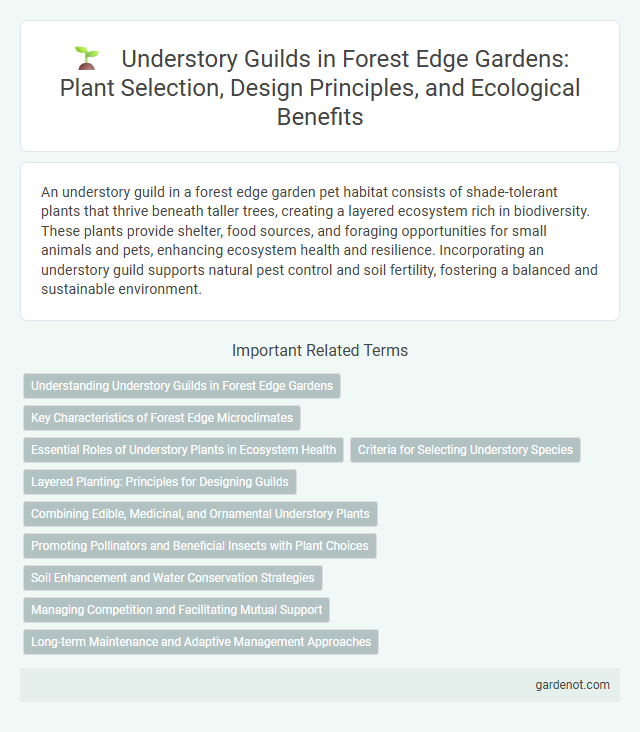An understory guild in a forest edge garden pet habitat consists of shade-tolerant plants that thrive beneath taller trees, creating a layered ecosystem rich in biodiversity. These plants provide shelter, food sources, and foraging opportunities for small animals and pets, enhancing ecosystem health and resilience. Incorporating an understory guild supports natural pest control and soil fertility, fostering a balanced and sustainable environment.
Understanding Understory Guilds in Forest Edge Gardens
Understory guilds in forest edge gardens consist of shade-tolerant plants that thrive beneath the canopy, enhancing biodiversity and soil health. These guilds include nitrogen-fixing shrubs, perennial herbs, and ground covers that create a microhabitat supporting pollinators and natural pest control. Understanding the interactions within understory guilds optimizes space, improves resilience, and promotes sustainable forest edge ecosystems.
Key Characteristics of Forest Edge Microclimates
Understory guilds in forest edge gardens thrive in microclimates characterized by dappled light, moderate humidity, and protected soil moisture levels, creating optimal conditions for shade-tolerant plants. These microclimates support a rich biodiversity by balancing sunlight exposure and wind shelter, promoting healthy growth of shrubs, herbs, and groundcovers beneath the canopy. The temperature regulation and moisture retention at forest edges enhance nutrient cycling and plant resilience critical to effective understory guild development.
Essential Roles of Understory Plants in Ecosystem Health
Understory plants in a forest edge garden play essential roles in enhancing ecosystem health by improving soil fertility through nitrogen fixation and organic matter contribution. These plants provide critical habitat and food sources for pollinators, insects, and small wildlife, promoting biodiversity and ecological stability. Their root systems help prevent soil erosion and maintain moisture levels, supporting the overall resilience and productivity of the garden ecosystem.
Criteria for Selecting Understory Species
Understory species in forest edge gardens are selected based on shade tolerance, growth habit, and ecological compatibility with overstory plants. Species must thrive in low-light conditions, contribute to soil health through nitrogen fixation or leaf litter, and support local biodiversity by providing habitat or food for pollinators and wildlife. Optimal understory plants include native ferns, shade-loving perennials, and low-growing shrubs that enhance ecosystem stability and resilience.
Layered Planting: Principles for Designing Guilds
Understory guilds utilize layered planting principles to maximize biodiversity and resource efficiency by combining root, groundcover, shrub, and small tree species that occupy different vertical niches. This stratification enhances light capture, soil fertility, and pest control within forest edge gardens. Selecting complementary plants based on their functional roles--such as nitrogen fixation, pollinator attraction, and biomass accumulation--ensures a resilient and productive ecosystem.
Combining Edible, Medicinal, and Ornamental Understory Plants
An understory guild in a forest edge garden strategically integrates edible, medicinal, and ornamental plants to maximize space and biodiversity while enhancing ecosystem resilience. Key species such as shade-tolerant herbs like wild ginger (Asarum canadense) provide ground cover with edible rhizomes, medicinal benefits, and aesthetic appeal through their lush foliage. This combination supports pollinators, improves soil health, and creates a multifunctional, visually rich understory layer beneath the canopy trees.
Promoting Pollinators and Beneficial Insects with Plant Choices
Selecting native flowering plants like milkweed, goldenrod, and wild bergamot in an understory guild enhances habitat for pollinators such as bees, butterflies, and hummingbirds. Incorporating herbs like yarrow, dill, and fennel attracts beneficial predatory insects including ladybugs and lacewings, which help control pest populations. These strategic plant choices boost biodiversity, improve pollination rates, and create a balanced ecosystem along the forest edge garden.
Soil Enhancement and Water Conservation Strategies
The understory guild in forest edge gardens enhances soil fertility by incorporating nitrogen-fixing plants such as clover and comfrey, which improve nutrient cycling and organic matter content. Mulching with leaf litter and wood chips reduces evaporation, maintaining soil moisture and promoting microbial activity crucial for water retention. Deep-rooted species like daikon radish break up compacted soil layers, facilitating water infiltration and reducing runoff in these agroforestry systems.
Managing Competition and Facilitating Mutual Support
In a forest edge garden understory guild, managing competition involves strategically selecting shade-tolerant plants with complementary root depths to minimize resource overlap and optimize nutrient uptake. Facilitating mutual support through beneficial plant pairings enhances soil fertility, pest resistance, and microclimate regulation within the guild. This balance improves overall productivity and resilience, supporting a sustainable forest edge ecosystem.
Long-term Maintenance and Adaptive Management Approaches
Understory guilds in forest edge gardens require long-term maintenance strategies such as selective pruning, soil health monitoring, and periodic mulching to support plant diversity and resilience. Adaptive management approaches include regular assessment of species performance and integrating native plants to enhance ecosystem stability and pest resistance. These practices ensure sustainable growth and optimize ecological functions by responding dynamically to environmental changes.
Understory guild Infographic

 gardenot.com
gardenot.com